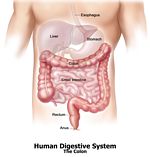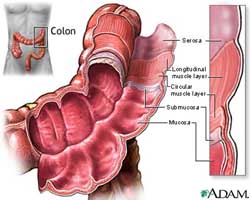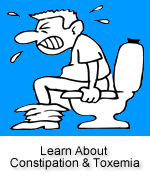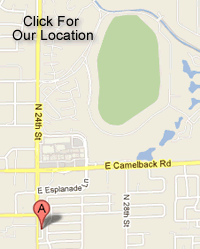How Your Colon Works
The colon, or the large intestine, is a tubular organ approximately 5.5 - 6.0 feet in length and 2.5 - 3.0 inches in diameter.
Although most absorption occurs in the small intestine, the ascending colon also absorbs some minerals, nutrients and excess water from the digested residue of the food that you have eaten.
The contents of digestion (chyme) are moved along by mass muscular movements (peristalsis), which are initiated by the nerve supply to the colon. Toxins and waste materials are then discharged through the rectum and anus. The process of digestion and elimination normally takes between 12 and 24 hours.

|
|
Chart of Human Colon
|
|
click to enlarge
|
A large portion of the immune system resides in the large intestine. When the colon is healthy, you will experience a feeling of well-being because you are assimilating and eliminating properly.
To ensure a healthy colon, we have observed that sufficient water, good nerve tone, and the proper biochemical nutrients and intestinal flora are needed.
The cecum controls the amount of undigested waste, or chyme, that enters the colon from the small intestine. As well as food wastes, the chyme may consist of predigested food, water and secretions from the small intestine, liver and pancreas.
Once the chyme enters the cecum, final digestion begins. The colon is supported by haustrum, the small sacs in the colon wall produced by the arrangement of muscle fibers.
The muscles gather and release to push the feces to the rectum. The haustrum also cause the cells in the wall lining to secrete a mucus which lubricates the colon and assists the transit of the feces.
As the feces makes its way through the ascending, transverse and descending sections, it is constantly churned, processed and assimilated until it reaches the sigmoid, where it is stored until a bowel movement occurs. A bowel movement is prompted by the entrance of food into the stomach.

|
|
Structure Of The Colon
|
|
click to enlarge
|
When fecal matter is retained in the sigmoid or in the colon, the remaining water in the feces is absorbed by the colon wall, making the feces hard.
The harder the feces, the more difficult it is to eliminate.
When the colon is impacted with fecal matter, very few friendly bacteria can survive and unhealthy bacteria form. Unhealthy bacteria feed on the undigested proteins and organic compounds in the feces and produce toxic by-products.
When the colon becomes obstructed with hardened fecal matter, the absorption of nutrients and elimination of waste material slows. The mucus and feces in the colon putrefies. This toxic decay is then absorbed into the body by the blood capillaries. Storing fecal matter in any area of the body creates irritation, inflammation and disease.
Maintaining the health of your colon means avoiding a toxic bowel. Exercise and a proper diet will decrease your chances of a toxic bowel. Replenishing friendly bacteria through supplementation with acidophilus or other probiotics is commonly recommended by practitioners after a series of colonics.
|



